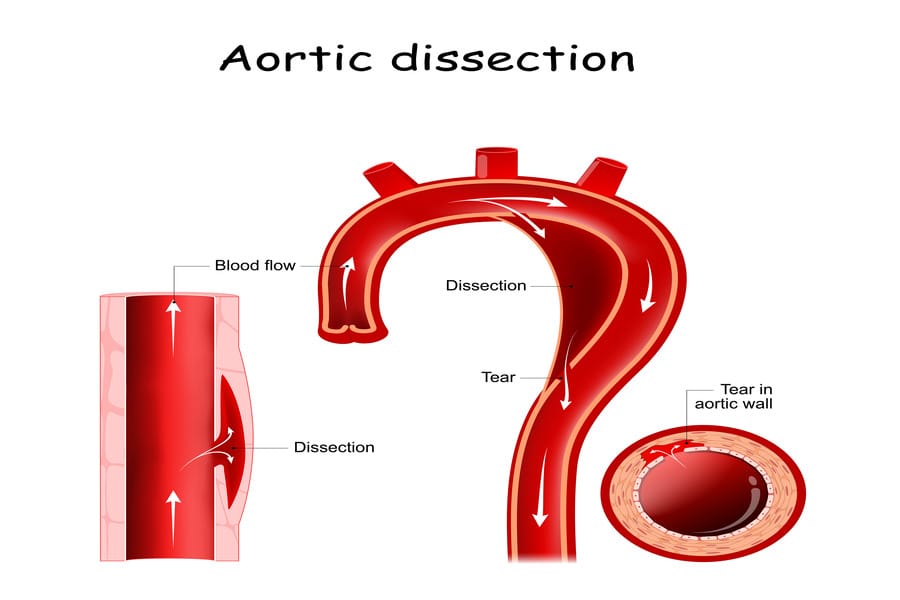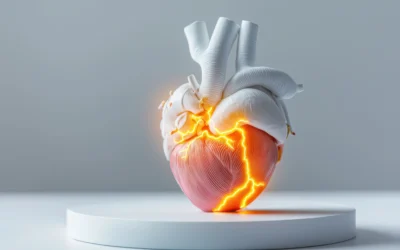In the realm of cardiovascular ailments, aortic dissection stands as a condition of significant concern, demanding prompt attention and understanding. This article aims to shed light on the intricacies of aortic dissection, offering insights into its definition, symptoms, causes, risk factors, and preventive strategies.
What is Aortic Dissection?
Aortic dissection refers to a serious condition wherein the inner layer of the aorta — the large blood vessel branching off the heart — tears. Blood rushes through this tear, causing the inner and middle layers of the aorta to dissect or separate. Aortic dissection is a medical emergency and can lead to fatal complications if not promptly addressed.
Overview
The aorta, responsible for delivering oxygen-rich blood to the body, is a vital part of the cardiovascular system. It runs from the heart through the chest and abdomen. Depending on where the dissection occurs, aortic dissections are classified as:
- Type A: This involves a tear in the ascending part of the aorta (near the heart). It’s the more common and more dangerous form.
- Type B: This involves a tear in the descending part of the aorta.
Symptoms
Recognizing the symptoms of an aortic dissection is crucial for timely intervention. They may include:
- Sudden severe chest or upper back pain, which may radiate to the neck or down the back.
- Shortness of breath.
- Loss of consciousness.
- Weakness or paralysis on one side of the body.
- Difficulty speaking, loss of vision, or other symptoms similar to a stroke.
- A weak pulse in one arm compared to the other.
- Excessive sweating.
It’s essential to note that symptoms can vary based on the type and location of the dissection.
Causes
While the exact cause of an aortic dissection isn’t always identifiable, certain conditions and factors can lead to the weakening of the arterial walls:
- High Blood Pressure: Chronic hypertension is the most common cause, as it places significant stress on the arterial wall.
- Atherosclerosis: The hardening and narrowing of arteries can increase the risk.
- Congenital conditions: Conditions like Marfan syndrome, which affects the body’s connective tissue.
- Trauma: A severe injury, like a car accident, can cause dissection.
- Pregnancy: Rarely, women can experience aortic dissections during pregnancy.
Risk Factors
Certain factors or conditions can elevate the risk of experiencing an aortic dissection:
- Age: People between 60 and 70 years are more at risk.
- Gender: Men are more likely to develop aortic dissection than women.
- History of heart surgery or procedures.
- Family history: Having a family member with aortic dissection can increase the risk.
- Cocaine use: This drug can raise blood pressure, leading to increased risk.
How to Avoid It
A proactive approach can considerably reduce the risk of aortic dissection:
- Monitor Blood Pressure: Keeping hypertension in check is pivotal. Regular check-ups, lifestyle adjustments, and medications can help.
- Avoid Tobacco: Smoking or using any form of tobacco weakens the blood vessels.
- Healthy Lifestyle: Adopting a balanced diet and regular exercise routine can improve overall cardiovascular health.
- Limit Alcohol: Excessive drinking can raise blood pressure. It’s best to limit intake.
- Avoid Cocaine and Stimulant Drugs: These can lead to severe hypertension.
When to See a Doctor
The symptoms of an aortic dissection can resemble other conditions, like a heart attack. However, if you experience severe chest or back pain, or any other symptoms mentioned above, seek emergency medical attention immediately. Early detection and treatment can be life-saving.
Additional Information
Post-diagnosis and treatment, individuals with aortic dissection will need regular imaging tests to monitor the condition. Medications to control blood pressure will likely be a long-term recommendation. In some cases, surgery might be required to repair the aorta or replace the affected section.
Aortic dissection, while critical, is a condition that can be managed and treated with timely intervention. Knowledge, awareness, and a proactive approach to health can make all the difference. Regular medical check-ups and a heart-healthy lifestyle play an indispensable role in ensuring cardiovascular well-being.









